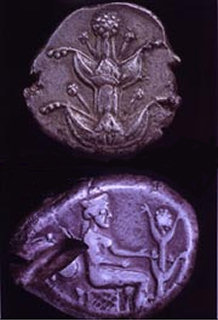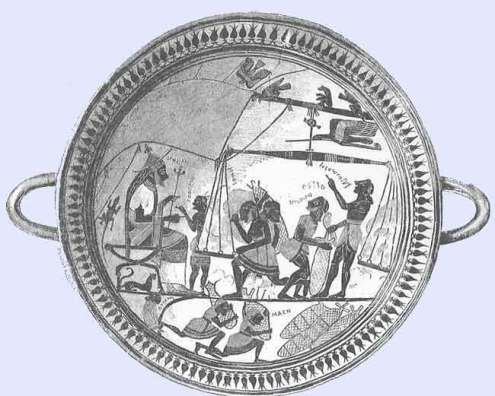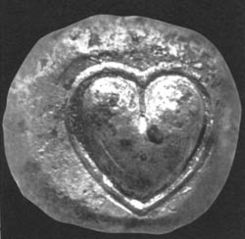Silphium (also known as silphion or laser) was a plant that was used in classical antiquity as a rich seasoning and as a medicine. It was the essential item of trade from the ancient North African city of Cyrene, and was so critical to the Cyrenian economy that most of their coins bore a picture of the plant. The valuable product was the plant's resin (laser, laserpicium, or lasarpicium).
Silphium was an important species in prehistory, as evidenced by the Egyptians and Knossos Minoans developing a specific glyph to represent the silphium plant. It was used widely by most ancient Mediterranean cultures; the Romans considered it "worth its weight in denarii" (silver coins). Legend said that it was a gift from the god Apollo.
The exact identity of silphium is unclear. It is commonly believed to be a now-extinct plant of the genus Ferula, perhaps a variety of "giant fennel". The still-extant plant Ferula tingitana has been suggested as another possibility. Another plant, asafoetida, was used as a cheaper substitute for silphium, and had similar enough qualities that Romans, including the geographer Strabo, used the same word to describe both.
Link: http://en.wikipedia.org/wiki/Silphium
Mais texto sobre a planta:
The Lost Panacea of Silphium

 Silphium, here seen on Cyrene's coins, was the colony's chief export. The plant was notoriously resistant to cultivation, and is believed to have been harvested to extinction within the first few centuries AD.
Silphium, here seen on Cyrene's coins, was the colony's chief export. The plant was notoriously resistant to cultivation, and is believed to have been harvested to extinction within the first few centuries AD.
Silphium was so strongly desired by various ancient civilizations that it was, at times, valued above currency. With some Romans contending that the plant was a gift from the god Apollo, its extinction was considered a great tragedy. Pliny even wrote that the last known Silphium plant was given to the Roman Emperor Nero himself.
 An artifact from the 6th century believed to depict King Arcesilaus II of Cyrene overseeing the weighing of Silphium.
An artifact from the 6th century believed to depict King Arcesilaus II of Cyrene overseeing the weighing of Silphium.
The Egyptians shared the Romans’ veneration of the plant, associating its with human love and sexuality. The Egyptian glyph signifying the heart portion of the soul, in fact, may have been meant to picture the seed of the Silphium plant. This character, known to the Egyptians as Ib, is likely the origin of our modern heart symbol.
 Here is an ancient Cyrene coin bearing the image of a Silphium seed. Its likeness both to the Egyptian Ib and to the modern heart symbol is striking.
Here is an ancient Cyrene coin bearing the image of a Silphium seed. Its likeness both to the Egyptian Ib and to the modern heart symbol is striking.
While the world has been without Silphium and its powers for well over a millennium, our modern culture still bears its mark. Every time a love-dazed youth carves a heart into a tree or inserts a whimsical, heart-shaped emoticon into an online conversation, the plant that once commanded a king’s ransom is winking at us from the ghostly recesses of the Earth’s past. Like the Dodo bird that gave us an insult implying stupidity or the dinosaur that inhabits every child’s imagination, Silphium’s potency is strong enough to overcome the silencing power of extinction itself.
Link:
http://irrationalgeographic.wordpress.com/2009/07/08/the-lost-panacea-of-silphium/
Mais texto sobre a planta:
The Lost Panacea of Silphium

Native to the ancient Greek colony of Cyrene (located in modern day Libya), Silphium (also known as laser) is an extinct plant that, in its heyday, was one of the most treasured medicinal resources of the ancient world. Employed by cultures all around the Mediterranean, Silphium was used as a spice, a cure-all medicinal remedy, a form of birth control, and an agent for pregnancy abortion. Famed scholars ranging from Pliny the Elder to Herodotus to Theophrastus all wrote of Silphium’s legendary potency. Despite its widespread popularity, Silphium allegedly refused to grow anywhere aside from Cyrene. The colony became so closely identified with the plant that it appears on the settlement’s coins.

Silphium was so strongly desired by various ancient civilizations that it was, at times, valued above currency. With some Romans contending that the plant was a gift from the god Apollo, its extinction was considered a great tragedy. Pliny even wrote that the last known Silphium plant was given to the Roman Emperor Nero himself.

The Egyptians shared the Romans’ veneration of the plant, associating its with human love and sexuality. The Egyptian glyph signifying the heart portion of the soul, in fact, may have been meant to picture the seed of the Silphium plant. This character, known to the Egyptians as Ib, is likely the origin of our modern heart symbol.

While the world has been without Silphium and its powers for well over a millennium, our modern culture still bears its mark. Every time a love-dazed youth carves a heart into a tree or inserts a whimsical, heart-shaped emoticon into an online conversation, the plant that once commanded a king’s ransom is winking at us from the ghostly recesses of the Earth’s past. Like the Dodo bird that gave us an insult implying stupidity or the dinosaur that inhabits every child’s imagination, Silphium’s potency is strong enough to overcome the silencing power of extinction itself.
Link:
http://irrationalgeographic.wordpress.com/2009/07/08/the-lost-panacea-of-silphium/

Nenhum comentário:
Postar um comentário